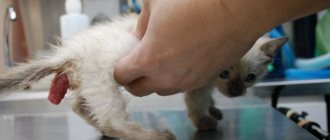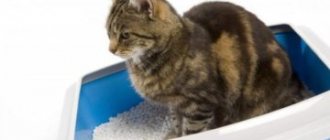Hepatitis in cats and cats, as a rule, is quite complicated, since it is an inflammatory process that occurs in the liver tissue. Like any inflammation that disrupts the normal functioning of the affected tissues, hepatitis leads to the fact that the liver practically “does not work.” And if you know all the functions that this organ performs, then it becomes clear where certain symptoms of the disease come from. Today we will tell you in detail about the types, causes, symptoms and methods of treating hepatitis in cats.
Liver functions
Let's start with the basics in order to understand the full scope of the situation. Let's figure out what functions the liver performs in cats.
Digestive and metabolic regulating
The liver is also involved in the digestion process, although it is more accurate to say that this organ is a connecting link between the digestive and circulatory systems. Proteins and fats are broken down thanks to the work of the liver (however, it not only breaks down incoming substances, but also forms new ones necessary for life). Don’t forget about glycogen, which is stored until “rainy days.” In addition, the liver regulates the release of hormones (in particular, adrenaline and norepinephrine).
Formation and secretion of bile
And it is excreted into the duodenum. It is what helps break down food (however, it performs several other functions, which you will learn about in the text below). Bile is formed in liver cells using blood. When hemoglobin is broken down, bilirubin is formed, which is the bile pigment. Bile helps activate enzymes (in particular lipase), which break down food.
Absorption of fats and synthesis of vitamins
Rather, this function can be “assigned” to bile, which (as already written above) emulsifies fats. But they can be absorbed only after they combine with bile acids. After the gallbladder “gives up” the secretion accumulated in it, the intestines begin to contract better (peristalsis increases, which contributes to the normal movement of food through the gastrointestinal tract).
Vitamin A is formed in the liver, and vitamin K and nicotine are also “stored”.
Regulating Blood Glucose Levels
The next function of the liver “follows” from the previous paragraph – regulation of glucose levels in the blood. As soon as it rises, the liver immediately begins to make “reserves”, forming and storing glycogen. When there is not enough glucose, these reserves are destroyed, as a result, blood sugar returns to normal. However, if your pet has problems with the concentration of glucose in the blood, but the liver is absolutely healthy, then most likely the cat has diabetes.
"Purification" and "storage" of blood
Excessive amounts of medications/hormones/vitamins, metabolic “waste” - all this “settles” in the liver. But if too much of this “nasty” accumulates, the liver begins to die, and the toxins are again spread through the blood throughout the body, poisoning it. The liver is well supplied with blood vessels. Blood not only passes through this organ, as if through a filter, but is also retained. Therefore, if as a result of an injury there is severe blood loss, then the liver “gives up” its reserves in order to somehow replenish the volume of circulating blood.
Protective function
This is not only about cleansing the blood of toxins, but also about disinfecting it from bacteria. The liver, “sacrificing” itself, retains microorganisms to the maximum (cells are capable of phagocytosis). Therefore, even if a pet gets sick with salmonellosis (or another microbe decides to “annoy” the mustache), the liver suffers. And the veterinarian, having noticed the symptoms of an infectious disease, as well as signs characteristic of liver inflammation, will probably tell you that the cat has viral hepatitis. And this is not due to poor qualifications of the specialist or lack of experience, no, this diagnosis is general. Like ARVI in our country. The doctor does not say which pathogen led to inflammation of the respiratory tract in us; the same can be said about viral hepatitis in cats.
Why is a liver needed? Take a look at this short and clear video:
How much blood does it take for the virus to be transmitted from a person?
Transmission most often occurs through contact with blood. Speaking about how much blood is needed to become infected with hepatitis C, it is worth noting that this, first of all, depends on the viral load of the patient. If it is very tall, then a trace amount will be enough. Therefore, infection often occurs when:
- administering substances with one syringe;
- provision of unsafe medical care;
- transfusion of low-quality blood and its components.
But additionally, it is worth considering factors such as the activity of the virus and the percentage of its content in the patient’s blood.
Is hepatitis transmitted from cats to humans?
Surely, this question interests many: is it possible to get hepatitis from a cat? Is contact with a sick animal dangerous?
If a pet is diagnosed with viral hepatitis, then the person should not worry about becoming infected. Even if the cat’s liver is damaged due to infection, hepatitis itself is not transmitted! The most dangerous thing a sick pet can do is that it can “share” the pathogen. There is a much higher risk that another cat will become infected than a person.
There can't even be any talk about hepatitis C. Viral hepatitis in cats and hepatitis C in humans are completely different diseases. Their etiologies are different! Therefore, it is impossible to get hepatitis C from a cat!
First signs of illness
The consequences of gastroenteritis, long-term treatment with drugs, poisoning by pests or poor-quality products can cause the breakdown of liver cells. The first warning sign for the owner should be a change in the color of the mucous membranes. Liver hepatitis in cats is characterized by the fact that the tongue and oral cavity become icteric. The normally affectionate animal may become restless when petted, especially when the area where the liver is located is touched.
Vomiting, diarrhea, and sudden weight loss can complement the picture of the disease. The pet must be shown to a doctor immediately. You should not treat the disease yourself. Correctly prescribed treatment will help avoid negative consequences. Hepatitis in a cat is not a death sentence. The veterinary clinic will definitely do tests, based on them they will make a diagnosis and prescribe appropriate treatment.
Types of feline hepatitis
There are 2 types of hepatitis in cats - non-infectious (toxic) and infectious (bacterial, fungal, viral)
Non-infectious (toxic)
Toxic hepatitis in cats develops not only due to the ingestion of poisons into the animal’s body (including medications, especially if their dosage is exceeded or they are combined incorrectly). Some drugs can accumulate. The liver retains them to protect the body. But sooner or later the “dam” will break. And everything accumulated will enter the bloodstream. The result is an overdose. And an inflamed, irritated and “tired” liver will no longer be able to quickly and efficiently cleanse the blood.
In order for the poison to enter the bloodstream, it is not necessary to eat it. The toxin can enter through the respiratory system (for example, a cat inhaled fumes), through the skin (the pet ran through pesticide-treated beds, drops may be applied to the withers or cosmetics are used), bites of poisonous snakes/insects, or by injection (most often when treating the animal ).
Don't forget about parasites. Firstly, they release toxins during their life processes. And if the degree of invasion is high, then a lot of poison is released. The body is already weakened, depleted, the immune system “sends” all of its energy to fight helminths. Therefore, the liver has a hard time. And secondly, there are also parasites that live in the liver and “clog” the bile ducts, which leads to serious inflammation.
Infectious (bacterial, fungal, viral hepatitis)
Most often, infectious hepatitis in cats is the underlying disease. Even if the pathogen does not “targetedly” infect the liver, it will still get into it (through the bloodstream). However, despite the huge classification of microorganisms, the most common diagnosis is viral hepatitis. Why is that? Yes, because it is impossible to say exactly what virus led to the disease. This diagnosis is rather general, so the veterinarian makes it clear that the disease is infectious in nature.
Complications after hepatitis
Even with timely and well-chosen treatment, veterinarians cannot always prevent disruptions in the functioning of the liver. Most often, cat owners face the following consequences:
- Hepatic lipidosis. A disease in which liver tissue is replaced by fatty tissue.
- Ascites. A pathology characterized by the accumulation of transudate in the peritoneum.
- Hepatic encephalopathy. The disease occurs due to blood contamination with ammonia and waste products of parasitic organisms.
In advanced cases, hepatitis develops into cancer or cirrhosis.
Cirrhosis is often accompanied by abdominal dropsy
Causes of hepatitis
Next, let's talk about the reasons for the development of hepatitis in cats, hepatitis in cats.
Non-infectious
As mentioned above, there may be several reasons for the development of non-infectious hepatitis in a cat.
- Toxins enter through the gastrointestinal tract
. In first place, perhaps, is the intake of toxins through the digestive tract. For example, an animal’s food is constantly of poor quality (moldy or sour). The cat could have eaten a houseplant (they love to chew the leaves and stems), but it is poisonous to him. He could also catch a mouse that had been poisoned by someone with rat poison (arsenic or other zoocides). And the role of self-medication deserves a separate topic. “Caring” owners stuff their pets with everything. Sometimes they use human drugs, sometimes they exceed the dosage (some out of ignorance, others in the hope that recovery will come faster), sometimes they even give medications that are prohibited for cats. - T oxins enter through the skin and lungs.
Less commonly, the liver is affected by toxins that enter through the skin or lungs. Only if the animal is constantly exposed to toxic substances. If a cat inhales toxic fumes once, this does not mean that she will soon be diagnosed with hepatitis. Timely detoxification therapy will help the liver recover quickly. However, if an animal often inhales poisons, or its skin is constantly in contact with dangerous substances, then sooner or later liver problems will make themselves felt. - Parasites
. This includes the release of toxins and mechanical damage to the liver itself (if helminths parasitize it, attaching firmly with hooks and suction cups). Liver tissue injured by worms becomes more susceptible (the gates to infection open).
Viral
Viral hepatitis develops in cats due to the fact that the pet’s liver “takes the blow” as soon as the mustache gets sick. If you have carefully read about the functions of this organ, then you already know that the liver is a “filter”, a barrier that traps pathogenic microorganisms (by phagocytosis). Yes, this reduces the concentration of the pathogen in the blood, but the liver suffers greatly. Therefore, almost any infectious disease causes the development of viral hepatitis in a cat.
Symptoms
Symptoms of hepatitis in cats are often so obvious that it is almost impossible not to notice them.
- The most noticeable is jaundice. And the mucous membranes (in the mouth, conjunctiva of the eyes), and the whites of the eyes themselves. The more the liver is affected, the stronger the yellowness.
- If a cat has infectious hepatitis, the symptom will be an increase in body temperature. Fever will certainly be followed by lethargy and loss of appetite (up to complete refusal of food).
- Vomit. Often with bile.
- Diarrhea (less commonly constipation). The feces are practically uncolored. The color of feces is provided by bilirubin, which is part of bile. If the liver functions are impaired (not enough bilirubin is produced), then the cat’s feces are gray or gray-yellow (almost colorless).
- Vomiting and diarrhea can cause your cat to become dehydrated. And to replenish fluid reserves, the animal drinks very greedily.
- Since the liver (natural filter) does not fully cope with its task, the kidneys have to work almost completely exhausted. Due to the fact that bile pigments enter the blood (and not excreted with bile into the duodenum), the urine becomes dark. In addition, protein can be detected in urine during laboratory diagnostics.
- The liver increases in size (with inflammation, any organ becomes larger than normal). Normally, this organ does not protrude beyond the last rib (on the right side). With hepatitis in a cat, liver enlargement can be “detected” not only by careful palpation, but also by percussion (“tapping”).
The animal will give itself away because it will be in pain. You can suspect problems with the liver without percussion or palpation. As soon as you take the animal in your arms, it begins to worry. Sometimes the cat hisses and bites when he is picked up or held close.
A biochemical blood test will help make the correct diagnosis. The amount of bilirubin will tell you whether your cat has liver problems or not.
Diagnostics
A comprehensive examination allows you to confirm feline hepatitis and, as a rule, find out the cause of inflammation. A large number of tests is not a doctor’s whim; without them it is impossible to assess the functionality of an organ. Mandatory are:
- stool analysis - coprogram, for helminth eggs, for occult blood;
- blood, urine - clinical, biochemistry 24 indicators. There are high levels of ALT, GGT, alkaline phosphatase, bilirubin, and globulin in the blood. Low levels of folic acid, cobalamin;
- serology – exclude toxoplasmosis, leukemia, immunodeficiency, peritonitis;
- X-ray of the abdominal cavity.
In all cases, an ultrasound is performed. This is a fairly informative method that allows you to assess the size and condition of internal organs, in particular the liver, gall bladder, and spleen (if the hepatic vessels are damaged, it is enlarged). The connective tissue is visible as white spots - their size and quantity make it clear how much the liver is damaged and whether the process is reversible.
The most informative study is laparoscopy or biopsy. Unfortunately, the material is collected under general anesthesia, which is not always acceptable. If the risk is acceptable, an additional bacteriological analysis of liver and bile tissue is performed to identify pathogenic bacteria.
Treatment
How to treat hepatitis in a cat? Treatment should be exclusively under the supervision of a veterinarian and compliance with the following rules:
- Without eliminating the cause that led to the disease, treatment of a cat with hepatitis will be ineffective. If intoxication has led to inflammation, then detoxification therapy must be prescribed.
- If necessary, administer antidotes (for example, in case of rat poisoning, give preparations containing vitamin K), reduce the concentration of poison in the blood (intravenous administration of physiological solutions).
- The liver must be supported (there are many hepatoprotectors, but Essentiale is the most common). The use of vitamins (in particular, from group B) gives good results.
- The animal needs help. For this purpose, antispasmodics (such as no-spa, for example) are prescribed, which help relieve pain.
- You need to be careful with antibiotics. You can’t cope without them, but you need to prescribe them carefully (the liver is already agitated). If a cat is diagnosed with viral hepatitis, the use of immunostimulants and antiviral drugs will be required.
- If allergy symptoms appear, then it is necessary to prescribe antihistamines.
By following all these rules, you will make it much easier to treat your cat for hepatitis. But we must not forget about nutrition, read on.
Feeding the cat
What to feed a cat with hepatitis? The diet must be carefully monitored. Nothing greasy!
For the first day after diagnosis, you will only have to keep your pet on water. Then gradually introduce porridge (give preference to rice, oatmeal). A little low-fat minced meat can be added only a week after the start of treatment for a cat with hepatitis (provided that the animal is getting better).
Some owners are interested in what folk remedies can treat a cat with hepatitis? Yes, drinking decoctions of chamomile and rose hips to a sick mustache gives positive results, but without eliminating the causes and using medications, it will not be possible to completely cope with the inflammation. Medicinal plants can slightly alleviate the condition, but will they cope with the pathogen if the cat has viral hepatitis?
Through a kiss on the lips
Speaking about whether it is possible to become infected with hepatitis C through saliva, it should be mentioned that sometimes the source of infection can be not only blood, but also other biological fluids, including saliva.
Also answering the question of whether it is possible to become infected through a kiss on the cheek, scientists emphasized that this is impossible. If we analyze another form, namely, whether it is possible to become infected through a kiss on the lips, then until recently the risk percentage was considered extremely low, but nevertheless such a mechanism is possible.
This is due to the fact that you can become infected through a kiss only if one of the partners has bleeding gums, and the other has damage to the oral mucosa.
When one of the family members is diagnosed with the disease, the question immediately arises of how one can become infected with hepatitis C at home. It is worth noting that all loved ones should be regularly examined, because the use of common items for personal hygiene purposes can cause the disease.
Prevention
As you know, the best treatment is prevention. Be sure to vaccinate your cat against hepatitis - do not wait until your pet becomes infected. In addition, the following rules for preventing this disease will help you:
- Vaccinate your animal on time. This will allow the immune system to develop and resist various pathogens. The stronger the immune system, the less the liver participates in protecting the body.
- Drive worms according to the schedule (quarterly).
- Do not feed raw fish or meat to your pet. This can lead to an infectious or parasitic disease (for example, opisthorchiasis).
- Do not feed spoiled food (sour, moldy).
- Don't feed fatty foods.
- Do not self-medicate. Or follow the dosage and frequency of administration of the drugs prescribed by your veterinarian.
- Do not keep your pet in poorly ventilated areas (especially if the house is being renovated). Keep all potential poisons (household chemicals, paints, fuels, solvents, pesticides, herbicides, etc.) out of reach of your pet.
- If you are treating the mustache for skin parasites or washing it, then be careful. Do not exceed the dosage of the drug. And wash off cosmetics thoroughly.
- Do not allow your cat to come into contact with homeless or suspicious animals. Such communication is potentially dangerous (there is a risk of contracting infectious or parasitic diseases).
We hope the article helped you! If you have any questions about hepatitis in cats, write in the comments!











